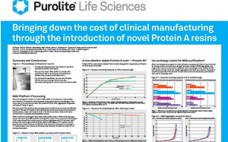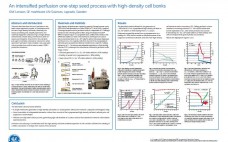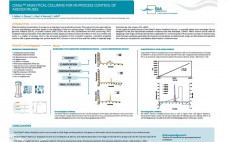Improvements in single-use systems have allowed implementing high-density cultures in standard work flows. The current study shows integration of the Thermo Scientific™ HyPerforma™ Single-Use Bioreactor (S.U.B.) and the XCell™ ATF6 Single-Use (SU) System to achieve high-density cultures. Current results are compared against similar cultures using a stainless steel ATF6 system. The S.U.B. was able to support high-density cultures (>40E06 cells/mL) without modification to standard single-use components and maintained proper operating parameters. Scale-up criteria for both S.U.B. and ATF are provided…
Poster Hall
Rapid and Simple Sample Preparation for High Throughput, High Resolution and Sensitive Glycan Analysis by Capillary Electrophoresis
Here, we report the simple and rapid GlycanAssure™ workflow that combines high throughput and high resolution glycan analysis of 96 samples in 7-9 hours using Applied Biosystems™ 3500xL 24-capillary electrophoresis system. The process eliminates vacuum drying and highly toxic cyanoborohydride in the labeling reaction. Use of Dynabeads™ magnetic beads for glycan purification post deglycosylation and removal of free dyes after labeling streamlines the process for automation. Capillary electrophoresis can detect less than 0.2 fmol/μL of labeled glycans. Two proprietary fluorescent…
Innovative Hydrophobic Interaction Chromatography (HIC) Resins for Next Generation Molecule Challenges
Advances in biotherapeutics are generating a wider range of biomolecules that are presenting unique and often difficult separation and purification challenges. Based on the complex needs of the industry a series of HIC prototypes were developed over a range of hydrophobicity. Utilizing extensive user input, design goals focused on development of resins with market leading resolution and capacity, as well as optimized surface and flow characteristics for increased throughput and high product recovery. All of which are typical pain points…
Decreasing Cost of Clinical Trials Through the Use of Two Novel Protein A Resins
Tackling the High Cost of Protein A in Early Clinical Phases The cost of Protein A resins is very high, commonly 5-10 times higher compared to standard chromatography resins. One way to address this issue is to use a less expensive Protein A resin during early clinical trials, where the risk of failure is higher and fewer cycles are run, and subsequently switch to a resin designed for manufacturing if the product makes it to PIII and beyond. The higher…
A Fresh Approach to Process and Cost Efficiencies in Early Clinical and Biosimilars Production
This poster will introduce Praesto™ AC protein A resin and ProcessReady pre-packed columns from Purolite. Platform processes for MAbs manufacturing have long been used to save time and costs. The use of highly productive, cost- effective resins in such platforms can magnify these savings, and the addition of ready-to use formats can further enhance process efficiencies. Our approach is to maximize these efficiencies and cost savings in early clinical-phase production and in the manufacture of biosimilars by using stage-appropriate materials…
CryoPod™ Carrier: Standardized Portable Cryogenic Handling of Cellular Therapies
Temperature control during sourcing, manufacturing, and delivery of cell therapies is crucial, as fluctuations can affect viability and function of the cells, and potentially, the overall efficacy and safety of the therapeutic product. In many cell therapy workflows, source cells arrive cryopreserved at LN2 temperatures (-150 to -196 °C) and post-manufacturing, cells are again cryopreserved and stored in vapor- or liquid phase LN2 prior to their use in the clinic. In either case, containers filled with dry ice (-50 to…
Efficient Optimization of CHO Cell Culture Medium and Feed for Increased Antibody Production
Traditional medium optimization strategies are labor intensive, costly, and time consuming. In this project, high-throughput screening technology was adopted along with statistical design to reduce costs and decrease time for optimizing culture conditions for maximized antibody production from a custom Chinese hamster ovary (CHO) cell clone. The presented work includes two phases: phase 1 for basal medium optimization and phase 2 for feed optimization. Phase 1 and phase 2 each have two rounds. A DoE screening methodology was used to…
An Intensified Perfusion One-Step Process with High-Density Cell Banks
Seed culture expansion is commonly performed in several consecutive batch cultures. Starting from a cryopreserved cell stock, the initial culture expansion is typically performed in shake flasks, while the final steps are performed, at greater scales, in bioreactor vessels. Such a procedure is time-consuming and labor intensive with multiple steps that introduce risk for mishandling and contamination. This work describes how the use of perfusion in the seed culture expansion process, in combination with the use of high-density cell banks,…
CIMac™ Analytical Columns for In-Process Control of Adenoviruses
Determining the concentration of viruses is a crucial step in any production process. The most commonly used methods for virus quantification are either based on the infectivity of the virus (plaque assay, TCID50) determination of their genomic material (qPCR), or protein content (SRID, ELISA) and are very cumbersome and time consuming. HPLC analytical methods represent a fast alternative to these assays since they provide information on the virus content and purity in a matter of minutes. In this work the…
The Use of Dynamic Control in Periodic Counter-Current Chromatography
The interest in continuous bioprocessing to introduce productivity gains and cost savings is rapidly growing. Periodic counter-current chromatography (PCC) is one suitable technological approach, enabling continuous downstream processing. However, implementation in downstream applications is still uncommon mainly due to perceived complexity in operation and process control strategies. This work demonstrates the dynamic control function of ÄKTA™ pcc 75 chromatography system when applied to a protein A capture step operated in a three-column PCC (3C PCC) setup. Dynamic control enables sample…










